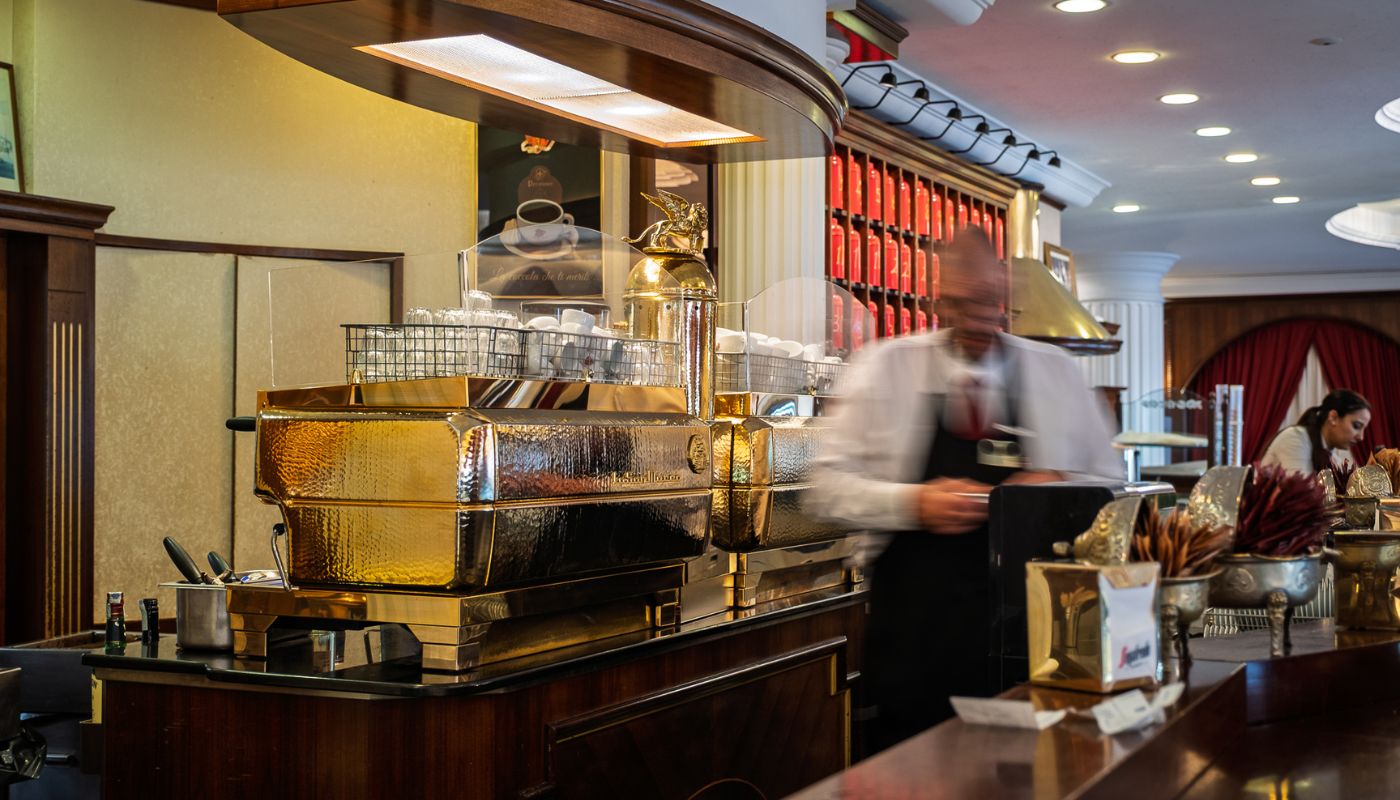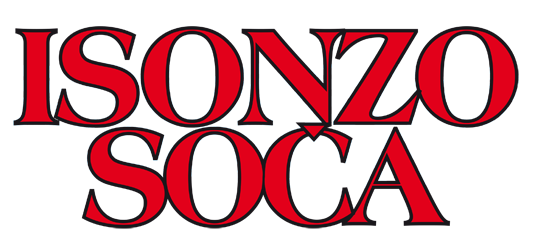
THE CITY OF COFFEE
by MIRT KOMEL
Every city, if it is really to be a city, must have coffee and coffee shops. And if it is now a well-known fact that Gorizia is — actually: Gorizia — the European Capital of Culture, then Trieste is definitely the European — not to say the world — the capital of coffee.
This is not from this year, not from last year, but from the time of the Austro-Hungarian Empire.
Charles VI did something at the declarative level in 1719 that Maria Theresa then implemented in full, namely: he declared Trieste to be Porto Franco, a “free port”. By doing so, he introduced a “free market” into the Austro-Hungarian “window to the world”, which, like any “free market”, was not really free at all, but, if we stick to coffee, supplied its mother directly from colonized countries, Ethiopia and Yemen. A mercantile scales have always needed a sword to be able to correctly point to the right ratio between price and quality of their goods.
The people of Trieste are coffee lovers, from head to toe, from seven in the morning to afternoon peta, and more and more. Location-wise, the love for coffee is of course flexible, as evidenced by all the legendary cafes you can visit in Trieste, from Caffè degli Spechi in Piazza dell’Unità d’Italia, to the “salotto buono della città”, which recently introduced the first robotic waiters to replace the precarious, through the legendary Caffè San Marco with its traditional interior and modern bookstore, all the way to Stella Polare on Ponte Rosso, where Joyce and Svevo, perhaps the godmother of the fact that caffè letterario is a notion in Trieste. But you don’t have to be a literate person to enjoy coffee. Today, coffee is everyone’s pleasure — anywhere. You can take it outside, in a café, you can take it at home, from the cafeteria, you can take it on the way out of the vending machine, you can carry it with you in a thermos. Nothing unusual. Any place is a good place for a shortcut of coffee. Unlike a clock.
In terms of time, drinking coffee in Trieste is slightly less flexible than its free spatial dimension. God forbid that after a certain hour — say noon — you order a cappuccino. Let alone cappuccino and brioche. Because then they will look at you strangely, as if you were a Martian or a Slovenian. Which you probably did if you ordered a cappuccino and brioche at three o’clock in the afternoon. That doesn’t work. Or you can order nero, which is the Trieste term for espresso (but not “ekspresso”, God forbid, because every time a Ljubljana resident in Trieste says “ekspreso”, someone falls off the motorbike and an angel in one of the many churches cries).
Espresso is still going. And not only at five in the afternoon, but also at nine or ten in the evening, because coffee is served after dinner. Coffee actually always fits in Trieste. There is not an hour when it would not be appropriate. Even in the middle of the night, if the machine is still running. And if not, you just take your home cafeteria and put it on the board — if you’re lucky enough to live in Trieste, or at least stay with someone. And of course, you were born in the right century, because in Friuli Giulia, coffee was the stuff of aristocratic circles, which emulated the court fashion of drinking freshly introduced coffee and cocoa at the time. With the rise of the bourgeoisie, coffee became a thing of the middle class, which could be afforded in cafes as a surplus of pleasure, provided by the surplus of value created by the proletariat. The latter could only afford coffee in the cafeteria, which made it possible for the workers to enjoy bourgeois coffee at home in the same way as the bourgeoisie enjoys it in cafes. Along with a cigarette, whatever, because coffee and a cigarette go together, hand in hand, like Joyce and Svevo.
The coffee machine, just like the home cafeteria, is, of course, an Italian invention.
Angelo Moriondo, an engineer from Turin, presented his invention in 1884 at the Expo of Turin, and in the same year he registered it as follows: “Nuovi apparecchi a vapore per la confezione economica ed istantanea del caffè in bevanda. Sistema A. Moriondo.” The Milanese Luigi Bezzera then perfected this Turin invention at the turn of the century — that is, in 1901, when Saussure was giving his Lectures on General Linguistics and Freud was writing the Interpretation of Dreams — and with the serial production started by Desiderio Pavoni, the bar coffee machine was able to expand. But it wasn’t until the post-war era, in 1947 to be exact, that Achille Gaggia perfected the bar machine with a lever that allows for a tighter extract of aroma that results in that distinctive crema that makes Italian coffee what it is, and by which everywhere else in Europe and the world you can distinguish “good” from “bad” coffee with biblical clarity. In Trieste, perhaps the most enterprising representative of coffee entrepreneurs is Illy, who founded Illycaffè in 1933, and two years later invented Illylett, the “nono of coffee machines”, together with a special technique of storing coffee under pressure, which allows the global achievement of its freshness.
The groundbreaking intellectual works of Freud and Saussure, mentioned above solely on the basis of historical coincidence, can help us understand many things, including the coffee we are talking about here. Saussure defined the linguistic sign as arbitrary, linear, differential, and coffees — if understood as a linguistic sign — adhere to exactly this same property: coffee is arbitrary because its association is “absolutely unmotivated”, an expression of the pure freedom of the individual who drinks it (no necessity dictates drinking coffee, but once you drink it, it is necessary); coffee is linear, because it can only be understood by chaining it one by one (just like letters that only make sense when you put them into words with other letters); Coffee is, after all, differential, as it acquires meaning only in relation to other coffees, with which it forms a peculiar “system of differences” (espresso differs from macchiato by a stain of milk, and the latter from sgociollato by a tiny drop of milk). It is by no means a coincidence what coffee is called, because it is the very name that gives rise to desire: you want, in the last resort, not the substance (pure espresso cream or cappuccino foam), but the form in which you pronounce it. If you’re an espresso lover, then you’re first and foremost a fan of what this coffee expresses through its signifier, and the same goes for monk cappuccino, Machiavellian machiatto, and so on.
The unconscious is structured like speech, but if we have already mentioned Freud and Lacan, let us go on to mention Marx and Althusser, who said that “ideology is as eternal as the unconscious.” We can be convinced of this precisely on the basis of coffee, which, like Aristotle’s “essence”, “is expressed in many ways”. It is by no means unimportant how, if we slowly return to Trieste, coffee is ordered: if you say, as was said in the introduction, “espresso”, the friendly waiter of Trieste will immediately know that he is dealing with “forešt” — correctly, in Trieste, it is called nero (“black” or “black”, because coffee in Italian is masculine, how: the sexual difference also crosses objects, as we wrote under the motto Pedoćina). The same applies to other coffees, namely that in Trieste they mean something completely different than elsewhere, such as, for example, if you order un capo you will not get “cappuccino” as it might sound to the first ear, but machiatto, but if you want taisto in a glass glass, you have to order capa and B, which at the signifier level represents the uniqueness of the Trieste coffee culture.
At this point, one has to ask oneself in a Shakespearean way, “Would coffee smell different under a different name?” Shakespeare would say no. Juliet would love her Romeo even if he wasn’t called Romeo, and despite the fact that it’s Montague and she herself spells Capulet. Also, coffee would smell the same, whether you call it espresso or nero. But after all, what does Shakespeare know about coffee? Nothing, or even less than nothing. Unlike Goethe, who drank coffee every day and found out where the magic coming from the coffee beans came from. Goethe, who loved women precisely because of their names and would therefore smell completely different to him under a different name, as evidenced by the poetry he dedicated to the name of his beloved. But neither Shakespeare nor Goethe knew Trieste to fall in love with Trieste coffee — unlike Joyce.
Joyce, who said that in a cup of coffee, when you mix it with a metal spoon and rub against its oval edges, you can “hear the sea.”
Joyce’s cup of coffee like a seashell in which the sea waves? The statement is joyful that it couldn’t be more, especially since he made it in Trieste, a seaside town where you can hear the sea all the time, as long as they are not drowned out by motorcycles or seagulls. The summer myth of the shell, in which you can hear the sea even when you take it back home to the hills, stands in stark contrast to the Joycean cup of coffee, in which the sea echoes, because you can’t take it home. If you do the same thing anywhere else, it doesn’t work.
You can hear the sea in a cup of coffee joyfully only in Trieste.
Prvotni jezik tega članka je slovenščina.

